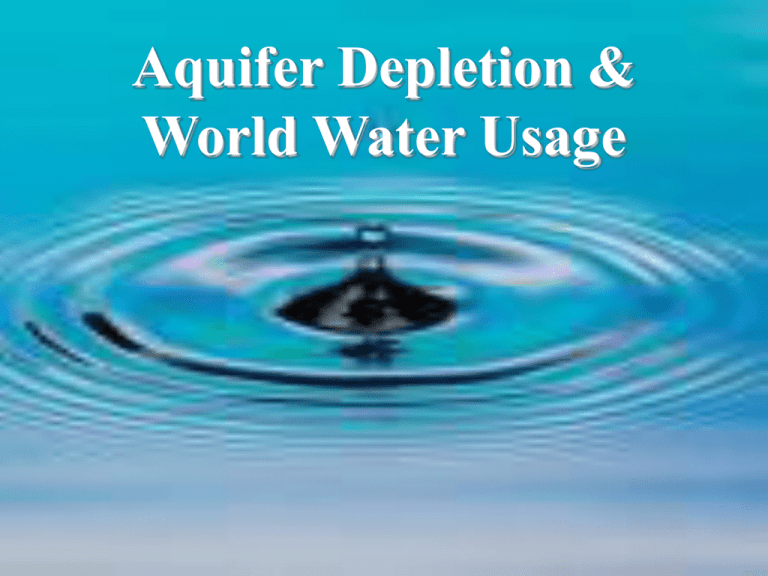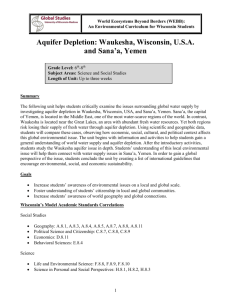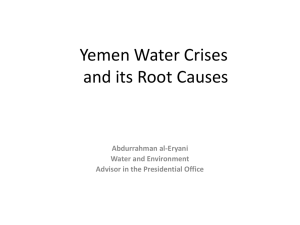Aquifer Depletion & World Water Usage
advertisement

Aquifer Depletion & World Water Usage A glance at the globe suggests an inexhaustible supply of water. • However, only about 3% is fresh water. • Of that 3%, 70% is locked in glaciers 29% is found underground in aquifers 1% is found in lakes, rivers, & streams The World’s Water Supply Source: http://www.purdue.edu/dp/envirosoft/groundwater/src/supply2.htm Groundwater is . . . • An important source of fresh water (represents over 90% of the world's readily available fresh water). • Located in aquifers -- underground layers of porous rock and soil. • Result of rain water seeping into the ground, eventually finding its way into aquifers. • This underground water moves very slowly and may take a long time to recharge or refill. Groundwater Source: http://ga.water.usgs.gov/edu/earthgwaquifer.html People around the world use the earth’s supply of liquid fresh water for various purposes. • Agriculture (42%) • Electricity generation (39%) • Homes/offices/hotels (11%) • Manufacturing and mining (8%) Global water use has changed over time. What does this graph tell you about water withdrawal and consumption since 1900? Source: http://www.unep.org/vitalwater/15.htm. For more info and graphs see UNEP website. • The demand for water is increasing due to: Population growth Better technology making it easier to access water • But, the earth’s freshwater supply is limited. Water & Population • The world’s population is growing at about 80 million people a year. • Therefore, an additional 64 billion cubic meters of water need to be found each year. Better Technology • People access groundwater through wells either by hand or by diesel/electric pump. • Diesel/electric pumps allow people to access water much more easily than by hand. Aquifer Depletion • As the demand for water increases, deeper wells must be dug. • Water from deeper below the earth’s surface is more likely to be contaminated with naturally occurring minerals, such as radium, because it has been in contact with rock formations for hundreds or thousands of years and minerals have dissolved into the water. • Since aquifers recharge slowly, wells will eventually run dry. Aquifer Depletion in Waukesha, Wisconsin, USA, and Sana’a, Yemen Sana’a, the capital of Yemen, is located in the Middle East, one of the most waterscarce regions of the world. Waukesha is located near the Great Lakes, an area with abundant water resources. Both regions risk losing their supply of fresh water as their aquifers are depleted. Waukesha & Water: A Historical View • Late 19th century, Waukesha was a resort town known for the healing properties of its mineralrich water. • Lake Michigan was polluted. • Officials in Chicago and Milwaukee looked to Waukesha as a water source. • In one incident in 1892, the people of Waukesha used pistols, pitchforks, and fire hoses to protect their water supply from speculators. Source: Barringer, F. (2005, August 12). Growth Stirs a Battle to Draw More Water From the Great Lakes. New York Times. Waukesha Today • Today, Waukesha is depleting its aquifer. • Its population increased 4.4% between 2000 and 2005. • Population of city of Waukesha = 67,658. • Population increase has led to increased demand for water. Waukesha • Deeper and deeper wells have been dug. • The current water level is more than 600 feet below its original level. • Deeper wells = greater contamination of water. • Radium content of Waukesha’s water is more than double the acceptable level set by the EPA in 2000. • Radium exposure over a lifetime has been linked to higher risk of cancer. A Solution? • One solution proposed by City of Waukesha officials is to build a pipeline to access Lake Michigan water. • However, a water protection plan called “Annex 2001,” bans new diversions of water outside the Great Lakes natural basin. • Waukesha is 5 miles outside the Great Lakes basin. Therefore it cannot take water. • In spite of Annex 2001, city officials hope their proposal will be approved by U.S. and Canadian officials. • Supporters of this proposal state that the amount of water Waukesha would take would not stress the Great Lakes’ water supply. • Critics of Waukesha’s plan say that the problem is not that the amount of water used by Waukesha would damage the Great Lakes, but that a precedent will be set. • States in the West, desperate for water, (AZ, NV, and CA) could look to Great Lakes as potential water source. • Another suggested solution for Waukesha’s water supply issues is water conservation. • A third proposed solution is to obtain water from west of Waukesha which would cost twice as much. Waukesha Questions • Which of these solutions do you think is best? Why? • Can you think of some other solutions? Sana’a, Yemen • Sana’a, the capital of Yemen, is located at 7223 feet (2200 meters) above sea level, on a plateau surrounded by several mountains. • The old part of the city has been inhabited for more than 2500 years and was designated a UNESCO World Heritage city. • It is a generally dry place with low rainfall and limited surface water (few rivers or streams). • The main source of water in the region is groundwater. • Yemen has one of the highest population growth rates in the world at 3.6% (in comparison the U.S. has a population growth rate of 0.91%). • Sana’a, with a population of 1,747,627, is growing at an even higher rate as people move from the rural areas to the city. • The population increase raises demand for water for drinking and growing food. • Yemen is one of the world’s poorest countries. Sana’a Yemen • 60% of the people work as farmers. • Agriculture in the Sana’a basin area accounts for 80% of water demand. • Cultivation of qat (a tree that has leaves that are chewed as a stimulant in Yemen) and grapes (a cash crop) consume the majority of the water. Urban Farming, Sana’a, Yemen, Photo credit: FAO Better Technology Another reason for increase in water use is change from traditional farming and water management methods suitable for the region to modern farming techniques such as powerful water pumps which allow people to withdraw much more water. Sana’a and Aquifer Depletion • Sana’a’s aquifers are dropping at a rate of about 20 feet per year. • If this rate continues they will be depleted by the end of decade. • The groundwater is used in irrigated agriculture, industry, and households. Sana’a and Aquifer Depletion Continued • Due to low rainfall, the groundwater does not recharge at a rate that can keep up with current demand and is therefore a (mostly) nonrenewable resource. • In the Sana’a region farmers and the city are competing for water. Reasons for Overuse of Groundwater According to the United Nations Environment Program (UNEP) and the World Health Organization(WHO), the reasons for overuse of groundwater are: – Unclear water rights and thus unregulated extraction; – Fuel subsidies and low import duties on agricultural equipment; – High returns on cash crops; – Inefficient irrigation practices. Response to Crisis By Government • The Yemeni government has – prohibited the drilling of new wells without a permit – prohibited the establishment of new industries that consume large amounts of water. • However, this has not been enough to stop depletion of the city’s aquifers. Other Possible Solutions • Some other suggested solutions are to bring water from somewhere else, such as coastal desalination plants, or to relocate the capital. • Some solutions suggested by UNEP/WHO report were to reuse wastewater in the city and to conserve agricultural water. Sana’a Questions • Which of these solutions do you think is best? Why? • Can you think of some other solutions? Questions for both Waukesha and Sana’a • What are the similarities and differences between Waukesha and Sana’a? • Do you think each city needs a different solution? Why or why not? • If you could create international water supply guidelines that encouraged environmental, social, and economic sustainability what would they be?











